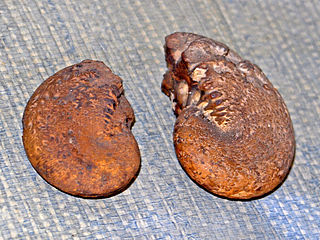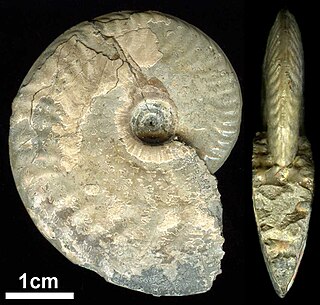
The Jurassic is a geologic period and stratigraphic system that spanned from the end of the Triassic Period 201.4 million years ago (Mya) to the beginning of the Cretaceous Period, approximately 145 Mya. The Jurassic constitutes the middle period of the Mesozoic Era as well as the eighth period of the Phanerozoic Eon and is named after the Jura Mountains, where limestone strata from the period were first identified.
The Mesozoic Era is the era of Earth's geological history, lasting from about 252 to 66 million years ago, comprising the Triassic, Jurassic and Cretaceous Periods. It is characterized by the dominance of gymnosperms such as cycads, ginkgoaceae and araucarian conifers, and of archosaurian reptiles such as the dinosaurs; a hot greenhouse climate; and the tectonic break-up of Pangaea. The Mesozoic is the middle of the three eras since complex life evolved: the Paleozoic, the Mesozoic, and the Cenozoic.
The Phanerozoic is the current and the latest of the four geologic eons in the Earth's geologic time scale, covering the time period from 538.8 million years ago to the present. It is the eon during which abundant animal and plant life has proliferated, diversified and colonized various niches on the Earth's surface, beginning with the Cambrian period when animals first developed hard shells that can be clearly preserved in the fossil record. The time before the Phanerozoic, collectively called the Precambrian, is now divided into the Hadean, Archaean and Proterozoic eons.

The Triassic is a geologic period and system which spans 50.5 million years from the end of the Permian Period 251.902 million years ago (Mya), to the beginning of the Jurassic Period 201.4 Mya. The Triassic is the first and shortest period of the Mesozoic Era and the seventh period of the Phanerozoic Eon. Both the start and end of the period are marked by major extinction events. The Triassic Period is subdivided into three epochs: Early Triassic, Middle Triassic and Late Triassic.

Ammonoids are extinct spiral shelled cephalopods comprising the subclass Ammonoidea. They are more closely related to living coleoids than they are to shelled nautiloids. The earliest ammonoids appeared during the Devonian, with the last species vanishing during or soon after the Cretaceous–Paleogene extinction event. They are often called ammonites, which is most frequently used for members of the order Ammonitida, the only remaining group of ammonoids from the Jurassic up until their extinction.

Ammonitida or "True ammonites" are an order of ammonoid cephalopods that lived from the Jurassic through Paleocene time periods, commonly with intricate ammonitic sutures.

Lytoceratina is a suborder of Jurassic and Cretaceous ammonites that produced loosely coiled, evolute and gyroconic shells in which the sutural element are said to have complex moss-like endings.

Ammonitina comprises a diverse suborder of ammonite cephalopods that lived during the Jurassic and Cretaceous periods of the Mesozoic Era. They are excellent index fossils, and it is often possible to link the rock layer in which they are found to specific geological time periods.
Zetoceras is an extinct ammonoid cephalopod genus from the suborder Phylloceratina that lived during the Early and Middle Jurassic in what is now Europe, and is included in the (family) Phylloceratidae.
Ussurites is an extinct ammonoid cephalopod genus belonging to the suborder Phylloceratina and is included in the family Ussuritidae. Its range is restricted to the early Middle Triassic, (Anisian)

Stephanoceratoidea, formerly Stephanocerataceae, is a superfamily of middle- upper Jurassic ammonoid cephalopods within the order Ammonitida containing diverse forms, generally with sharp ribbing and complex suture lines. Aptychi are believed to be mostly granular (Granulaptycus) or concentrically ribbed on the surface (Praestriaptychus)

Phylloceratidae is the predominant family of the Phylloceratina with some 15 or more genera found in rocks ranging from the Lower Jurassic to the Upper Cretaceous. Members of the Phylloceratidae are characterized by smooth, involute shells with very thin walls. Many are covered with fine growth lines but are usually without ribbing. Sutures are complex with the major and minor branches of the saddles with phylloid or spatulate endings.

Discophyllitidae are discoidal, generally evolute Phylloceratina from the Upper Triassic, derived from the Ussuritidae, in which the principal saddles of the suture have bifurcated or trifurcated endings, described as being di- or triphyllic. Discophyllitid shells are rather similar to those of the ancestral Ussuritidae and are distinguished primarily by the more complex suture. The Discophyllitidae provided the source for the Jurassic Phylloceratidae and Juraphyllitidae. Four genera are recognized and described.

Ussuritidae are ancestral, Triassic, Phylloceratina characterized by generally smooth, discoidal, evolute shells with rounded venters and little or no ornamentation and by sutures with primitive monophyllitic saddles with a single terminal branch or leaflet.

Berriasellinae is a subfamily of very late Jurassic and very early Cretaceous perisphinctoid ammonites in the family Neocomitidae. Berriasellinae comprises generally compressed, evolute genera, typically with furcated ribbing, and in some a smooth ventral band or groove. Berriasellinae are derived from the Ataxioceratidae and gave rise to the other Neocomitidae. The short lived Himalayitidae from the uppermost Jurassic have a similar appearance but differ in being generally broader and having sharper ribbing.

Perisphinctoidea, formerly Perisphinctaceae, is a superfamily of Middle Jurassic (Bajocian) to Lower Cretaceous (Barremian) ammonites, commonly with evolute shells with strong ribbing that typically divides about mid flank before crossing the venter.

Oppeliidae are compressed to oxyconic, sculptured Haploceratoidea, either unkeeled, unicarinate, bicarinate, or tricarinate; with sutures in great variety, but ribbing usually more or less falcoid or falcate. The Oppeliidae is the principal family of the Haploceratoidea, with the longest duration, extending from the Middle Jurassic (Bajocian) to the Upper Cretaceous (Cenomanian) Their derivation is from the Hildoceratoidea.
Hecticoceratinae is a subfamily of oppeliids from the Middle and Upper Jurassic typically with strong falcoid or falcate ribbing that covers whorl sides completely. Venters are usually keeled and may be tricarinate.

The Eastern Frontal Fault System is a megaregional system of oblique and thrust faults cross-cutting Colombia from Ecuador in the south to Venezuela in the north. The system from south to north covers ten out of 32 departments of Colombia; Nariño, Putumayo, Cauca, Huila, Caquetá, Cundinamarca, Meta, Boyacá, Casanare and Arauca. The Eastern Frontal Fault System underlies and affects the capitals of Putumayo, Mocoa, Caquetá, Florencia, Meta, Villavicencio and Casanare, Yopal. The fault system has a total length of 921.4 kilometres (572.5 mi) with a cumulative length of the faults of 1,821.8 kilometres (1,132.0 mi) and runs along an average northeast to southwest strike of 042.1 ± 19 bordering and crossing the Eastern Ranges of the Colombian Andes. The fault system forms the boundary between the North Andes microplate and the South American Plate.

The Lusitanian Basin is a rift basin remnant located on both the mainland and continental shelf off the west-central coast of Portugal. It covers an area measuring 20,000 square kilometres (7,700 sq mi) and extends north-south from Porto to Lisbon. The basin varies between approximately 130 kilometres (81 mi) and 340 kilometres (210 mi) in width and belongs to a family of periatlantic basins such as the Jeanne d'Arc Basin. To the east of the Lusitanian Basin lies the Central Plateau of the Iberian Peninsula. A marginal horst system lies to the west. The Alentejo and Algarve Basins connect to the southern end of the Lusitanian Basin. In the north, it connects to the Porto and Galicia Basins via an undersea ridge.















